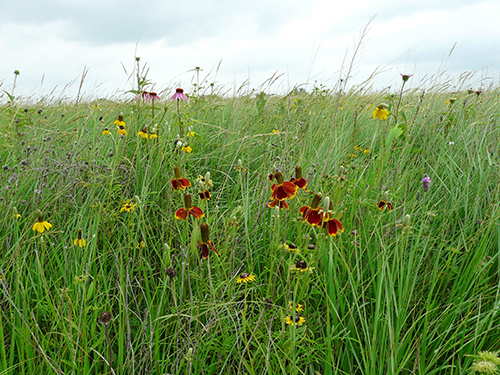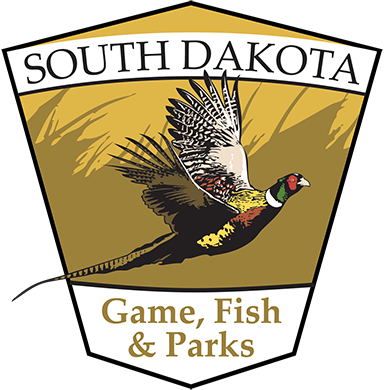grassland habitat
Grassland provides valuable habitat for wildlife in South Dakota. There are programs available to assist landowners with managing and creating grassland habitat for wildlife.

For questions on any of the programs listed in the sections below, habitat advisors are here to help. They possess the knowledge of federal, state and local programs to assist landowners in finding the right program(s) to meet their personal habitat and land use goals.
Grassland Habitat Programs
South Dakota Game, Fish and Parks Programs
The South Dakota Game, Fish and Parks' works with landowners and other conservation partners to implement grassland conservation practices on private lands across the state. Projects are designed to benefit a variety of wildlife species dependent upon these habitats while meeting the needs and management goals of landowners.
Partnerships with private landowners have been vital in the delivery of hundreds of projects benefitting wildlife and ranching operations. Successful partnerships with the ranching community are rooted in a common goal - sustainably managing South Dakota's grassland resources to support both livestock and wildlife.
GFP cost share options available to private landowners through the below practices:
- Upland Restoration
- Upland Enhancement - Grazing Management
- Wetland Creation and Enhancement
- Wetland Restoration Practices
- Pronghorn Friendly Fence
USDA Conservation Reserve Programs (CRP)
The USDA Farm Service Agency's (FSA) Conservation Reserve Program (CRP) is a voluntary program available to producers to help them safeguard environmentally sensitive land. Producers enrolled in CRP, plant long-term, resource-conserving covers to timprove the quality of water, control soil erosion and enhance wildlife habitat.
FSA provides participants with rental payments and cost-share assistance. Contract duration is between 10 and 15 years.
There are three ways to sign-up for CRP, general sign-ups and continuous sign-ups.
Eligible conservation practices include riparian buffers, wildlife habitat buffers, wetland buffers, filter strips, wetland restoration, grass waterways, shelterbelts, living snow fence, contour grass strips, salt tolerant vegetation, prairie strips and shallow water areas for wildlife.
CRP Programs in South Dakota
CRP Pollinator Habitat
This program requires a pollinator friendly cover of a diverse mix flowering plants and grasses that benefits pollinators all growing season long. Pollinator information can be found in the September/October issue of the Conservation Digest articles, Dakota Naturalist: Little Wings on the Prairie and Pollinator Predicament.
CRP South Dakota Pheasant SAFE
The goal of the South Dakota Pheasant SAFE project is to provide block grass acreages for pheasants and other upland birds in the form of nesting, brood-rearing, winter-roosting and escape cover to help increase their populations.
CRP Western South Dakota Grassland Wildlife Habitat SAFE
This CRP SAFE project strives to create breeding, nesting, brood rearing, winter and foraging habitat for grassland dependent birds. Specifically, the short-eared owl, grasshopper sparrow, dickcissel, bobolink, and sharp-tailed grouse prefer to nest in tall, dense cover typically provided by CRP. It will also develop habitat for non-game grassland birds, improve water quality and reduce soil erosion.
CRP Duck Nesting Habitat Initiative
The Duck Nesting Habitat Initiative aims to restore certain wetlands and associated uplands located outside of the 100-year floodplain in Iowa, Minnesota, Montana, North Dakota and South Dakota.
Restoring these wetlands will provide nesting ducks with critical habitat, nesting cover, security from predators and food.
CRP Wetlands Restoration Initiative
The Wetlands Restoration Initiative aims to restore flood plain and non-floodplain wetlands.
CRP Farmable Wetlands Program
The Farmable Wetlands Program restores wetlands and associated buffers on wetlands that have been cropped at least 3 out the previous 10 years.
Grassland CRP
This is a working lands CRP that pays landowners up to 75 percent of the county average grazing lease rental rate to place land into a 15 year CRP contract that allows annual use for grazing, hay, or harvest seed on the enrolled grassland acres. The grass can be expiring CRP or existing rangeland.
Contact information
For additional information on any of the CRP programs above, please contact a habitat advisor in your area or visit your local USDA Service Center office.

United States Fish and Wildlife Service Partners Program
The "Partners for Fish and Wildlife" program is administered by the United States Fish and Wildlife Service (USFWS) and provides a variety of technical and financial assistance options for grassland conservation on private and tribal land.
Typical conservation practices include grazing management and grassland restoration.
- Contact a USFWS private lands biologist for more information.
USDA Environmental Quality Incentives Program (EQIP)
EQIP provides financial and technical assistance to agricultural producers in order to address natural resource concerns and deliver environmental benefits such as improved water and air quality, conserved ground and surface water, reduced soil erosion and sedimentation or improved or created wildlife habitat.
Typical conservation practices include grazing management and grassland restoration.
USDA Conservation Stewardship Program (CSP)
CSP helps agricultural producers maintain and improve their existing conservation systems and adopt additional conservation activities to address priority resources concerns. Participants earn CSP payments for conservation performance - the higher the performance, the higher the payment.
USDA Agricultural Conservation Easement Program (ACEP) Agricultural Land Easements
The ACEP is a program that consolidates three former programs: Wetlands Reserve Program, Grassland Reserve Program and the Farm and Ranch Lands Protection Program.
NRCS provides financial assistance to eligible partners for purchasing Agricultural Land Easements that protect the agricultural use and conservation values of eligible land. In the case of working farms, the program helps farmers and ranchers keep their land in agriculture. The program also protects grazing uses and related conservation values by conserving grassland, including rangeland, pastureland and shrubland. Eligible partners include Indian tribes, state and local governments and non-governmental organizations that have farmland or grassland protection programs.
Under the Agricultural Land component, NRCS may contribute up to 50 percent of the fair market value of the agricultural land easement. Where NRCS determines that grasslands of special environmental significance will be protected, NRCS may contribute up to 75 percent of the fair market value of the agricultural land easement.
Second Century Habitat Fund Working Lands Habitat Program
The Second Century Working Lands Habitat Program provides both a short-term and longer-term working lands conservation alternatives to cropping marginal lands anywhere in South Dakota by adding important grassland habitat for wildlife to the landscape while also providing forage for livestock by allowing program acres to be managed with haying and grazing.
Participants in the Second Century Working Lands Habitat Program agree to establish a grass and flower mix on cropland acres for 5 or 10 years, and in return receive free seed and a one-time payment at the beginning of the contract of $150 per acre for a 5 year agreement or $450 per acre for a 10 year agreement in most counties west of the Missouri River and $250 per acre for a 5 year agreement or $750 per acre for a 10 year agreement in counties east of the Missouri River plus Lyman, Tripp, and Gregory County. Starting during the second growing season, participants can hay or graze the enrolled lands between August 1 and March 1, with annual haying limited to either half the enrolled acres every year, or the entire acreage every other year. There is a 5-acre minimum for this program.
Lands enrolled in the program are not required to be open to unlimited public hunting, although these acres are eligible to be enrolled in the Walk-In Area public hunting access program through GFP. Currently, landowners interested in enrolling their Second Century Working Lands Habitat acres in the Walk-In Area program can receive a one-time, up-front signing bonus of $10 per acre, per year to provide free public hunting access. On top of the signing bonus, they also receive the annual access incentive payments provided through GFP's Walk-In Area program.
The South Dakota Grassland Coalition also offers workshops, range tours, grazing classes and the like to landowners across the state. If this is an area of interest, please check out their events calendar.

